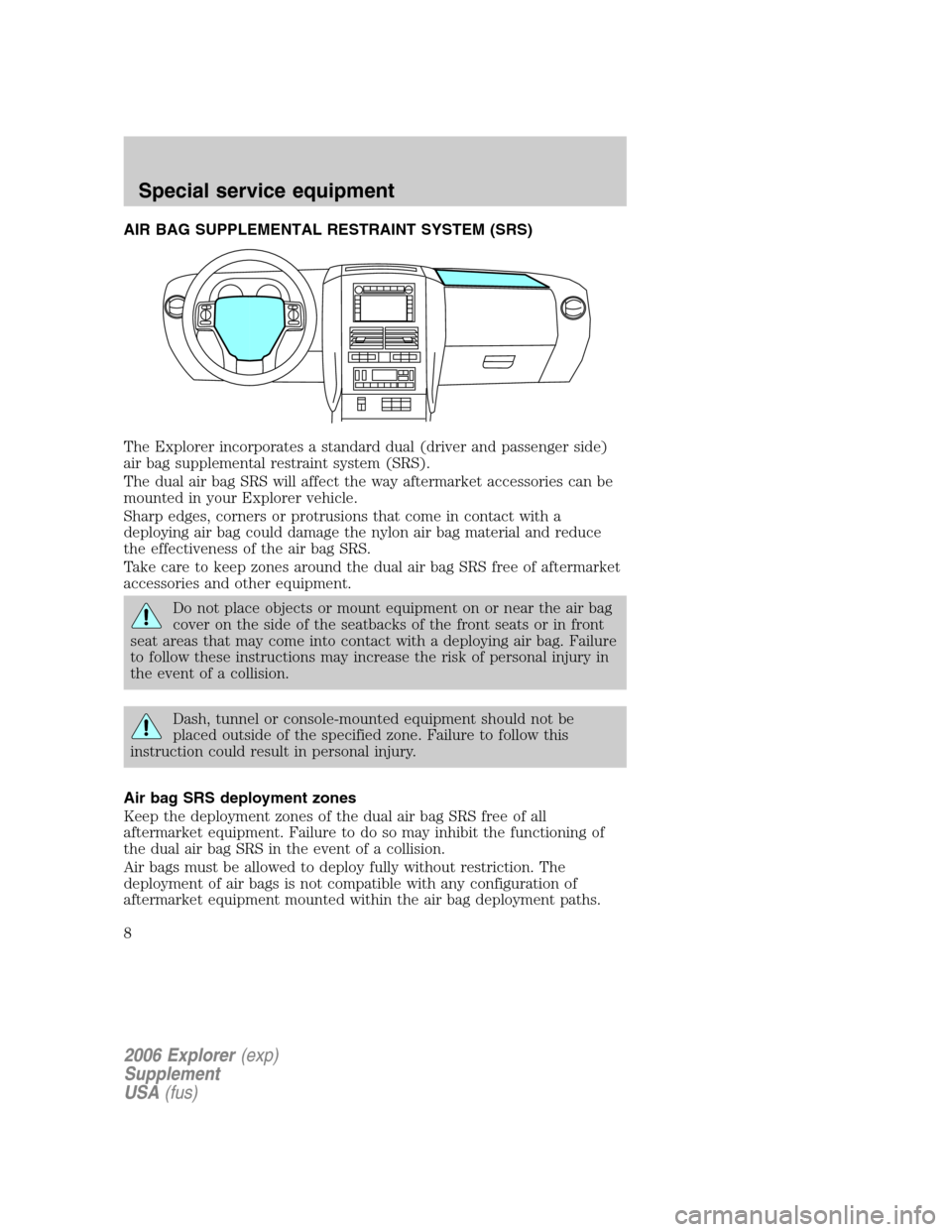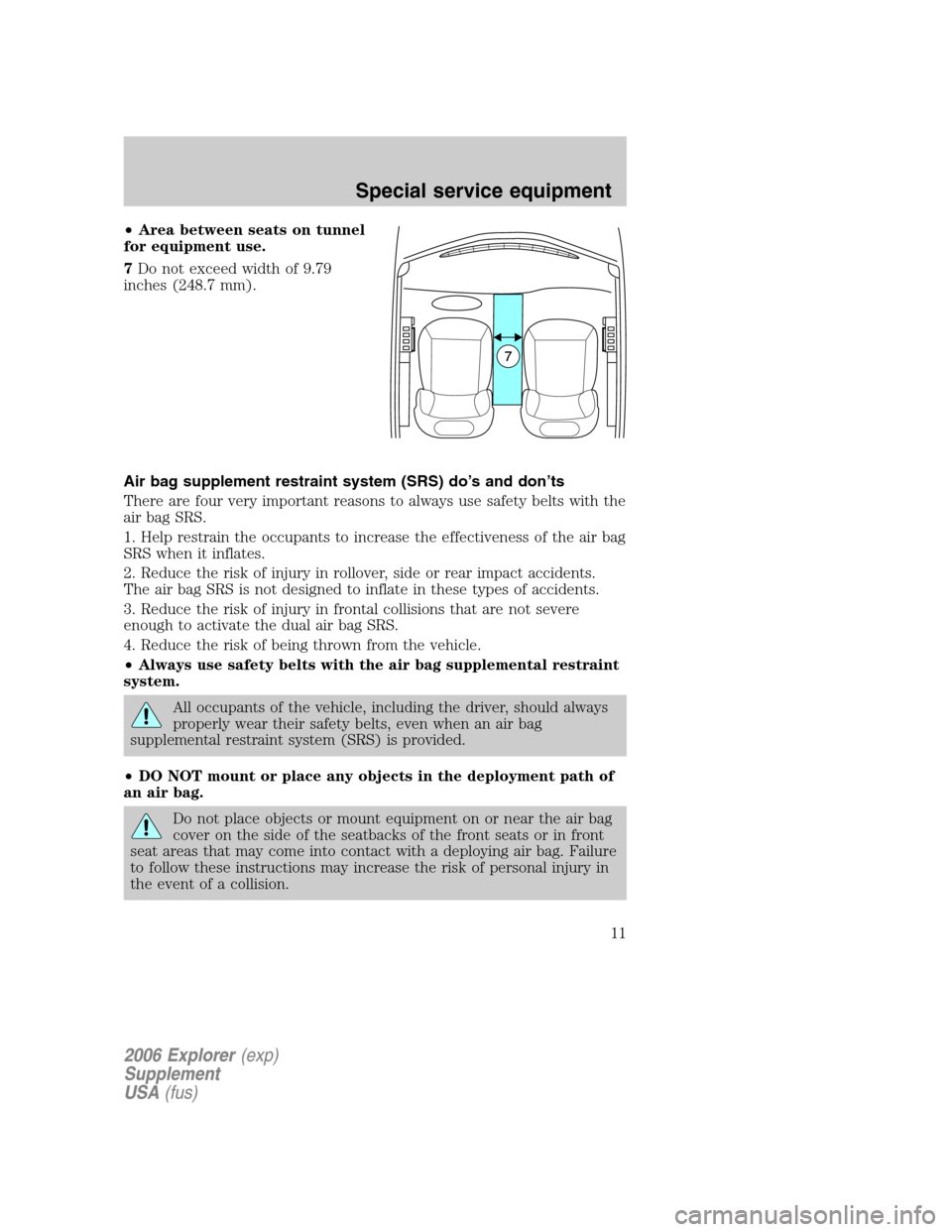Page 6 of 12

SPECIAL SERVICE OPTIONS
The Explorer is not designed nor intended to be used as a pursuit
vehicle or an ambulance.
Your vehicle’s optional equipment is designed to meet Ford Corporate
Product Standards. However, the equipment does not meet corporate
guidelines relative to police packages. Therefore, the optional equipment
is only intended for use in limited law enforcement service. Use of DSO
special service options does not imply nor allow use of your Explorer as
a pursuit vehicle (excessive speed), nor as an ambulance..
EQUIPMENT INSTALLATION
Important equipment installation information
When installing aftermarket equipment, avoid using fasteners that are too
long for the application or are in an area that might damage other
vehicle components (i.e., electrical wiring, brake lines, fuel tank and
lines, powertrain components, exhaust system, suspension, etc.).
When installing aftermarket equipment to the roof, be sure to locate
wires between the headliner and the roof before drilling. This will
prevent damage to the wire harness or interior headliner.
Do not make any electrical connections to the vehicle’s electrical system
at a point not specifically designed for installation of aftermarket
electrical equipment.
Do not install aftermarket equipment into the brake light circuit or any
other electrical circuit which is connected to the powertrain control
module (PCM), anti-lock brake system (ABS), air bag supplemental
restraint system (SRS) or transmission. Connecting into these systems
may affect engine and transmission operation and may cause vehicle
malfunction.
Do not install aftermarket equipment near the air bag deployment zones.
Failure to do so may inhibit the functioning of the supplemental restraint
system in the event of a collision. Refer toAir bag deployment zonesin
this chapter.
Do not place objects or mount equipment on or near the air bag
cover on the side of the seatbacks of the front seats or in front
seat areas that may come into contact with a deploying air bag. Failure
to follow these instructions may increase the risk of personal injury in
the event of a collision.
2006 Explorer(exp)
Supplement
USA(fus)
Special service equipment
6
Page 8 of 12

AIR BAG SUPPLEMENTAL RESTRAINT SYSTEM (SRS)
The Explorer incorporates a standard dual (driver and passenger side)
air bag supplemental restraint system (SRS).
The dual air bag SRS will affect the way aftermarket accessories can be
mounted in your Explorer vehicle.
Sharp edges, corners or protrusions that come in contact with a
deploying air bag could damage the nylon air bag material and reduce
the effectiveness of the air bag SRS.
Take care to keep zones around the dual air bag SRS free of aftermarket
accessories and other equipment.
Do not place objects or mount equipment on or near the air bag
cover on the side of the seatbacks of the front seats or in front
seat areas that may come into contact with a deploying air bag. Failure
to follow these instructions may increase the risk of personal injury in
the event of a collision.
Dash, tunnel or console-mounted equipment should not be
placed outside of the specified zone. Failure to follow this
instruction could result in personal injury.
Air bag SRS deployment zones
Keep the deployment zones of the dual air bag SRS free of all
aftermarket equipment. Failure to do so may inhibit the functioning of
the dual air bag SRS in the event of a collision.
Air bags must be allowed to deploy fully without restriction. The
deployment of air bags is not compatible with any configuration of
aftermarket equipment mounted within the air bag deployment paths.
2006 Explorer(exp)
Supplement
USA(fus)
Special service equipment
8
Page 9 of 12

Equipment mounted or placed within the deployment zones of the dual
air bag SRS will reduce the effectiveness of the air bags, damage the air
bags and potentially damage or dislodge the equipment, which may
result in personal injury.
Do not place objects or mount equipment on or near the air bag
cover on the side of the seatbacks of the front seats or in front
seat areas that may come into contact with a deploying air bag. Failure
to follow these instructions may increase the risk of personal injury in
the event of a collision.
Before mounting any equipment to your vehicle, refer to the following
illustrations for air bag deployment zones. Aftermarket equipment may
not be installed within the illustrated air bag deployment zones.
•Driver’s and passenger’s side air bag (deployed).
113.75 inches (349.25 mm) radius from center of air bag door.
217.72 inches (450 mm) from center of air bag door.
329.53 inches (750 mm) in width.
2006 Explorer(exp)
Supplement
USA(fus)
Special service equipment
9
Page 11 of 12

•Area between seats on tunnel
for equipment use.
7Do not exceed width of 9.79
inches (248.7 mm).
Air bag supplement restraint system (SRS) do’s and don’ts
There are four very important reasons to always use safety belts with the
air bag SRS.
1. Help restrain the occupants to increase the effectiveness of the air bag
SRS when it inflates.
2. Reduce the risk of injury in rollover, side or rear impact accidents.
The air bag SRS is not designed to inflate in these types of accidents.
3. Reduce the risk of injury in frontal collisions that are not severe
enough to activate the dual air bag SRS.
4. Reduce the risk of being thrown from the vehicle.
•Always use safety belts with the air bag supplemental restraint
system.
All occupants of the vehicle, including the driver, should always
properly wear their safety belts, even when an air bag
supplemental restraint system (SRS) is provided.
•DO NOT mount or place any objects in the deployment path of
an air bag.
Do not place objects or mount equipment on or near the air bag
cover on the side of the seatbacks of the front seats or in front
seat areas that may come into contact with a deploying air bag. Failure
to follow these instructions may increase the risk of personal injury in
the event of a collision.
2006 Explorer(exp)
Supplement
USA(fus)
Special service equipment
11